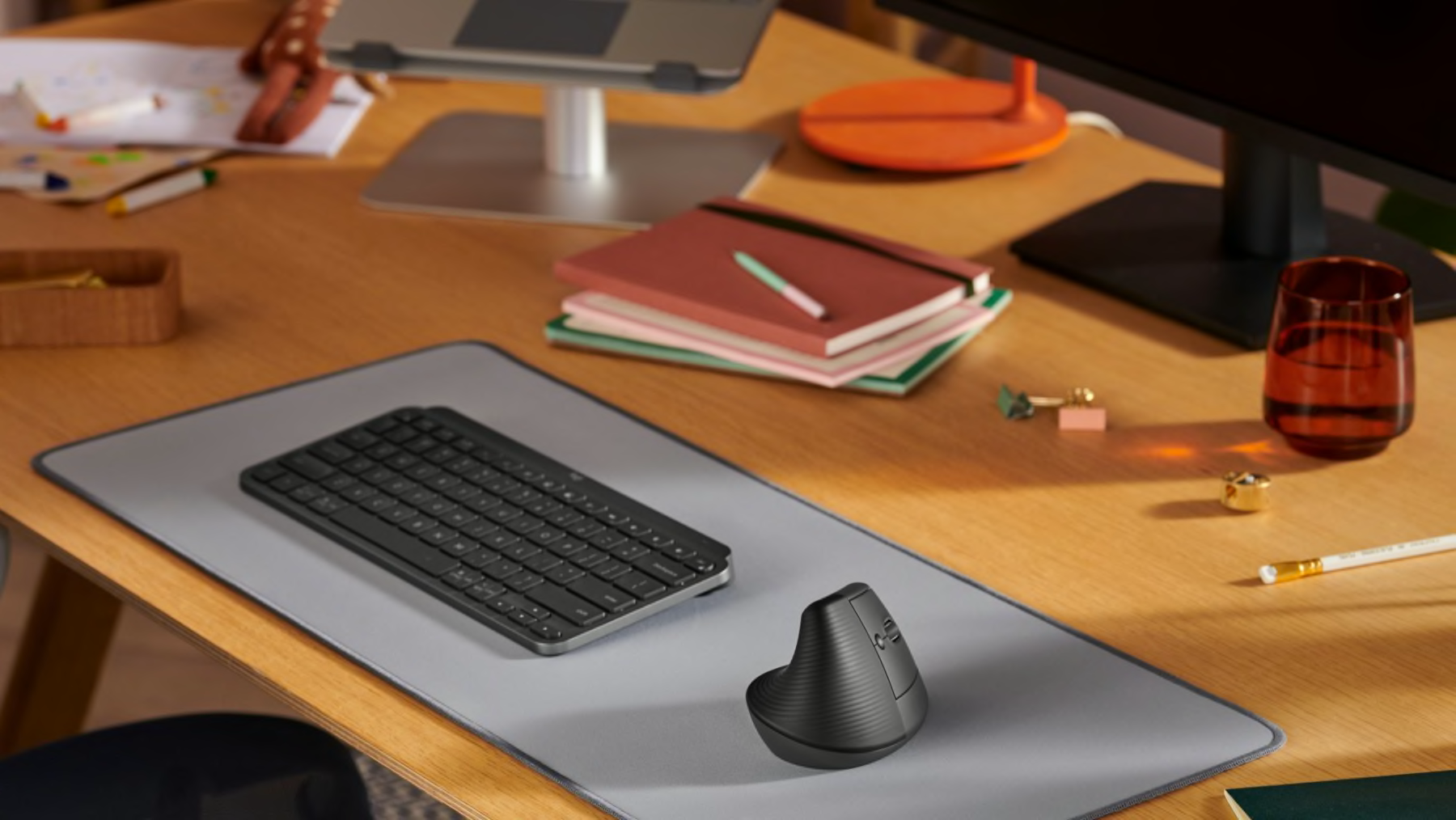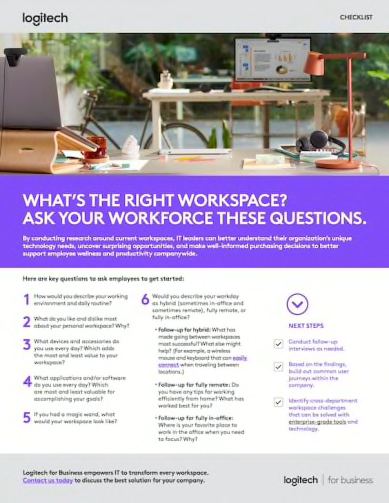WELLNESS CHECK:
Not all workspaces are created equal

The dynamic of working fully from home or from the office has radically changed. Businesses now have a chance to recognize the complementary roles that in-office collaboration and work-from-home productivity can play for their workforce.
However, many organizations have been slow to respond to these changes and focused on one-size-fits all solutions. Those who maintain the status quo and “see how it goes” miss out on a critical opportunity: Earning a real competitive advantage among their most valuable asset – their people.
“I feel energized that we get to rethink for the next 10 years.”
Google CEO Sundar Pichai, Wall Street JournalGoogle CEO Sundar Pichai’s Vision for Return to Work,” Wall Street Journal, February 2022.
IT leaders will play a major role in moving toward a new paradigm; one in which workspaces are transformed from good enough, to well enough. As they start to outfit employee setups accordingly, they must ensure every type of workspace is equipped to empower anyone’s best work.
This approach enacts a domino effect of positive change: Workspace equity can support employee wellbeing, which can support employee productivity, which can support successful business outcomes. Here’s how to get going in the right direction.
1. Define top use cases of each workspace
First, uncover which kind of workspaces your teams will use moving forward. It might not be as simple as it sounds: Even if a company is shifting to a permanent hybrid model on a large scale, an individual employee might be fully remote or fully in-office.
IT leaders should establish a way to document the variations of workspace models unique to each employee they support. From there, more broadly define what each workspace is likely to be used for within the organization and why.
Example use cases
Fully in-office
- Workers prefer in-person communication and find it easier to focus in the office than anywhere else
Fully remote
- Workers prefer to skip the commute and reclaim the time for focused, deep work
Hybrid
- Workers prefer to come into the office to collaborate and work from home when they need to be most productive
In every country, workers’ primary reason for wanting to come into the office in a hybrid model is to socialize and collaborate, according to recent global surveys from Gensler.“Across the Globe, Workers Want a Hybrid Work Model,” Gensler, 2020. “That means the core purposes of the office persists, but its power as a social and collaborative place are primary,” the reports conclude. “The preference for a hybrid model suggests that our time at the office may become more deliberate, targeted, and collaborative.”
A common hybrid model will split the type of tasks that get done in each workspace: Collaboration in the office, and focused productivity in the remote workspace.
2. Forecast wellness challenges of each workspace
Workspace initiatives within any business must be careful not to leave the fully remote or fully in-office workers behind. There is already a growing difference in experience. According to the Gensler global surveys, workers in a hybrid model “are more likely to report positive impacts on creativity, relationships, productivity, communicating, and problem solving” than workers in the office or remote full time.“Across the Globe, Workers Want a Hybrid Work Model,” Gensler, 2020.
This is where a crack in employee experience can start to form. If the majority of a team’s members prefer to collaborate in person, for example, a fully remote employee may unintentionally be left out of a conversation. Such a scenario’s mental wellness implications for the left-out remote employee cannot be understated. Even a single incidence of micro-exclusion can lead to a 25 percent decline in an individual’s performance on a team project.“Belonging: From comfort to connection to contribution,” Global Human Capital Trends Survey, Deloitte, 2020.
Example use cases
Fully in-office
- Are the mice and keyboards wireless and portable so workers can be mobile throughout the office?
Fully remote
- Are the workspace tools comfortable for longer working hours at the desk?
- Are workspaces set up to empower both collaboration and productivity?
Hybrid
- Does everyone have a chance to participate in a meeting if they want to?
- Are the workspace tools enterprise-grade and capable of robust connections, even in congested wireless environments?
Explicitly integrating wellbeing into the design of work is not the norm, according to Deloitte’s 2020 Global Human Capital Trends report, “representing a huge missed opportunity.” Organizations that are already redesigning work around wellbeing incorporated such tactics as introducing wellness behaviors in day-to-day work and rethinking workspaces themselves.“The Social Enterprise at Work: Paradox as a Path Forward,” Deloitte Global Human Capital Trends Report, 2020.
3. Create a workspace-assessment plan
Effective variables to consider when equipping a transformed workspace — from a worker’s app usage and hand size, to work locations and device types — can be studied and documented within your own organization.
Start with the right questions. Ask hybrid workers how their workflow will be divided up throughout the week, or query remote employees about how their technology can better support them in their home workspace.
This employee-specific research will inform technology deployment that offers a greater degree of personalization and accommodates different physiques, including left- or right-handed preferences. The mental stressors around tech issues can also be alleviated by ensuring enterprise-grade wireless connectivity and selecting software-empowered tools that streamline a workflow based on the end user’s personal preference.
4. Decide how to capture changes moving forward
While conducting employee workspace research and building out the workspace-assessment plan, it will also be smart to create a system that can evolve as workspace needs do – because they most certainly will.
Case and point: From 2018 to 2020 there was a 280 percent increase in the number of job listings that offered four-day work weeks.“The four-day work week is catching on amid coronavirus,” Quartz, 2020. Many businesses’ increased focus on upskilling and swapping team members based on project need, rather than siloed job roles, are further clues that what’s required of tomorrow’s workspaces will continue to change.
Selecting technology that is compatible with multiple apps and operating systems can ensure any workspace is equipped to help employees thrive today and tomorrow.

5. Transform every workspace
The desktop evolution is only beginning. Workspaces and the technology they’re equipped with can act as centering elements of any organization’s long-term wellbeing strategy. Transformed workspaces that support employee wellbeing – both physical and mental – are a clear path toward long-term productivity and business success.
The Logitech for Business lineup has a broad range of solutions to cover every workspace need, and the expertise to support every IT team.
WHAT’S THE RIGHT WORKSPACE? ASK YOUR WORKFORCE THESE QUESTIONS.

Download the Checklist
SUBSCRIBE TO OUR BUSINESS NEWSLETTER
THANK YOU FOR CONTACTING US
A product expert will reach out to you shortly.